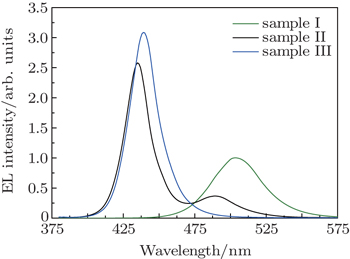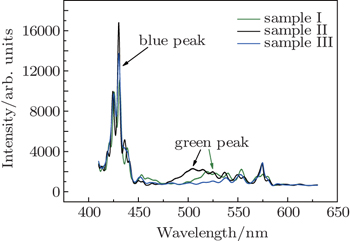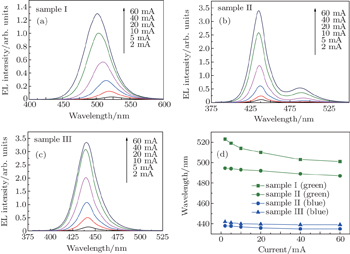† Corresponding author. E-mail:
Project supported by the National Natural Science Foundation of China (Grant No. 41171143).
The effects of Mg doping in the quantum barriers (QBs) on the efficiency droop of GaN based light emitting diodes (LEDs) were investigated through a duel wavelength method. Barrier Mg doping would lead to the enhanced hole transportation and reduced polarization field in the quantum wells (QWs), both may reduce the efficiency droop. However, heavy Mg doping in the QBs would strongly deteriorate the crystal quality of the QWs grown after the doped QB. When increasing the injection current, the carriers would escape from the QWs between n-GaN and the doped QB and recombine non-radiatively in the QWs grown after the doped QB, leading to a serious efficiency droop.
The commercialization of GaN base light emitting diodes (LEDs) has attracted much attention in recent years.[1–3] As LEDs are energy saving and have long life time, they have been considered as an ideal candidate for the next generation lighting source.[4,5] What is more, LEDs also open gates for many new applications, such as agriculture,[6] visible light communication,[7,8] and intelligent lighting.[9,10] One of the most challenging obstacles for the further development of the LED industry is the decreased LED performance under high injection currents, namely, efficiency droop.[11] The asymmetry of carrier transport is considered as an important factor of this issue.[12,13] For III-nitride materials, the hole concentration in the p-type layer is much lower than the electron concentration in the n-type layer, what is more, the hole mobility is much lower than the electron mobility. The low transportation ability of holes makes most of the carriers accumulated in the quantum wells (QWs) close to the p-GaN layer. The accumulation of carriers in the QWs close to p-GaN would induce not only the strong carrier leakage and Auger recombination, but also the low recombination efficiency in the QWs close to the n-GaN layer, both would lead to the efficiency droop.
Mg doping in the active layers has been proved to be useful for promoting hole transportation towards the n-GaN side, thus leading to the reduced efficiency droop.[14–17] However, even it is well known that the heavy Mg doping would induce non-radiative recombination centers in QWs and then deteriorate the peak efficiency of LED chips, few works have focused on its effect on the efficiency droop. Further investigation on the effect of Mg doping in the QBs on the efficiency droop of LEDs would give us deep insight into the phenomenon of efficiency droop.
In this paper, the effects of Mg doping in the QBs on the efficiency droop of LEDs are investigate through a dual wavelength method. It is found that only mediate Mg doping in the QB could lead to the reduced efficiency droop. Mg doping in the QB could enhance the hole transportation and reduce the quantum confined Stark effect (QCSE), both would modify the efficiency droop phenomenon. However, heavy Mg doping would seriously deteriorate the crystal quality of QWs grown after the doped QB. Under high injection currents, the carriers would flow over the doped QB and recombine non-radiatively in the following QW, leading to a serious efficiency droop.
In the experiment, three samples were prepared. All samples were grown on c-plane sapphire substrates by metal organic chemical vapor deposition (MOCVD). Thrimethylgallium (TMGa), thrimethylindum (TMIn), ammonia (NH3), biscyclopentadienylmagnesium (CP2Mg), and silane (SiH4) were used as gallium, indium, nitrogen, p-type and n-type dopant sources, respectively. After the deposition of the low temperature nucleation layer, the temperature was increased to 1050 °C to grow the 4-μm undoped and 2-μm Si doped GaN layers. The active region consisted of five periods of InGaN/GaN QWs. Four QWs close to the n-GaN side were designed to generate blue light, with the growth temperature of 730 °C. The QW close to the p-GaN side was designed to generate green light, with the growth temperature of 700 °C. All QBs were grown at the temperature of 830 °C. Then the 200 nm p-GaN layer was grown at 950 °C. All LED chips were fabricated with the standard lateral structure and the size of 250 μm × 500 μm. Cr/Pt/Au of the thicknesses of 70 nm/40 nm/1440 nm were evaporated as both the p-type and n-type electrodes. Then the metal contacts were annealed in N2 at 250 °C for 15 min under the atmosphere pressure. Photoluminescence (PL) measurement was carried out using the 325 nm line of a He–Cd laser. The electroluminescence (EL) of the packaged LEDs was measured in an integrating sphere at 300 K in a cw current mode.
The schematic LED structure is shown in Fig.
Figure
The EL spectra of the samples at the injection current of 30 mA are shown in Fig.
Unlike the EL measurements, the PL measurements excite the electron–hole pairs optically, thus excluding the effects of carrier electrical transportation on light emission. The PL spectra of the samples are shown in Fig.
From Fig.
There is another feature in the PL spectrum. When the Mg flow rate is increased from 0 to 10 sccm, the green peak shows a large blue shift. As the green QW is grown next to the doped barrier, this phenomenon may be explained by the reduction of the polarization field in the QWs by Mg doping. To confirm the explanation, the EL spectra of the samples with different injection currents are shown in Fig.
The wavelength shifts of the blue peaks in both samples II and III are almost the same, indicating that the QCSE in both samples are almost identical. The wavelength of the blue peaks of sample III is a bit longer than that of sample II, which is the result of the run to run variations considering the similar QCSE in both samples. As the blue QWs with better crystal quality contribute more to the luminescence of sample III, the peak efficiency of sample III is the highest. As we discussed above, the crystal quality of the green QW is deteriorated and the radiative recombination efficiency of the green QW is quite low in sample III. For the blue QWs only, the carrier distribution condition is not modified in sample III. When increasing the injection current, the carriers would escape from the blue QWs and recombine non-radiatively in the green QW, leading to the serious efficiency droop. As the blue QWs with better crystal quality and smaller QCSE contribute more in sample III, the peak efficiency of sample III is the highest. Thus it should be noted that the Mg doping concentration in the barriers must be carefully modified to realize the uniform light emission from all QWs and then the reduced efficiency droop.
We investigated the effects of barrier Mg doping on the efficiency droop of LEDs. The efficiency droop is only reduced for mediate Mg doping samples. Mediate Mg doping could enhance the hole transportation and reduce the QCSE, thus lead to the reduced efficiency droop. Heavy Mg doping would seriously deteriorate the crystal quality of the QWs grown after the doped QB. As a result, the carriers would flow over the doped QB and recombine non-radiatively in the following QW, leading to the serious efficiency droop under high injection currents.
| 1 | |
| 2 | |
| 3 | |
| 4 | |
| 5 | |
| 6 | |
| 7 | |
| 8 | |
| 9 | |
| 10 | |
| 11 | |
| 12 | |
| 13 | |
| 14 | |
| 15 | |
| 16 | |
| 17 | |
| 18 | |
| 19 | |
| 20 | |
| 21 | |
| 22 | |
| 23 | |
| 24 | |
| 25 |







